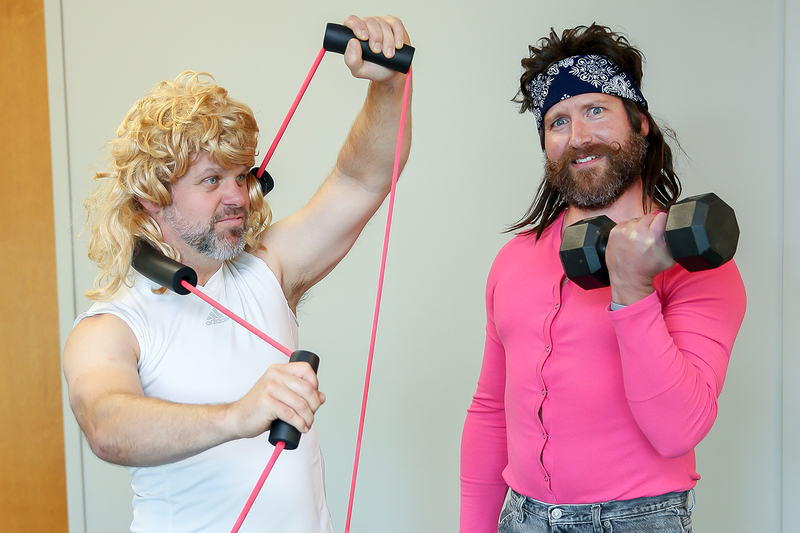News
5 Exercise Myths

Originally published in Vail Health Magazine 2018. Howard Head Sports Medicine’s Doug Emerson and Jesse Horton prove some common myths are just plain silly.
Have you heard that morning is the best time of day to work out? Or that you have to work out every day to see results? What about the one that says cardio is all you need to lose weight? These are just a few examples of the exercise myths you might read online or perhaps hear from friends in the gym. However, not everything you hear (or read) is true.
As physicians, PAs, PTs and other experts continue to explore the human body and conduct research, more and more myths are being put to rest. Here, our experts will bust five misconceptions you’ve probably heard, might believe and can now file away as myth.
1. There’s a "Best Time" to Work Out
This is a tricky one. There have been studies that indicate if you work out first thing in the morning, before you eat (i.e., in a fasted state), it helps prevent weight gain. Now, this is not the same as weight loss, but there do seem to be indications that early-morning exercise in the fasted state is more potent than an identical amount of exercise in the fed state, according to a study conducted by the Research Center for Exercise and Health at Catholic University Leuven in Belgium. However, the bottom line is that exercise should be a habit, so if you’re more likely to consistently work out later in the day or after work, do that.
2. Stretching Before Working Out Prevents Injuries
Stretching before a workout is not proven to help prevent injury, reduce muscle soreness or improve performance. In fact, you might even injure yourself if you simply jump into your workout with intense stretching, says Shirley Archer, a fitness and wellness educator with the American Council on Exercise. One of the most important aspects of injury prevention is warming up. Instead of hitting the deep stretches immediately, incorporate static stretching after you exercise, when your muscles and connective tissues are nice and warm. It makes lengthening them easier. Archer recommends holding a slow stretch for 10 or 15 seconds while taking deep breaths.
3. Sit-Ups are the best way to Work Your Abs
Everybody has heard that the best way to get that six-pack belly is to do sit-ups — hundreds and hundreds of sit-ups. Nay, not so! In fact, by 2020, the U.S. Army will phase out sit-ups from its standard fitness tests. If you want solid abs, work on your core. Planks, squats and push-ups all help tone abs more than sit-ups.
4. More Cardio Means More Weight Loss
The basic equation for weight loss is to make sure you’re expending more calories than you take in. If you walk or run on the treadmill for 30 minutes, you’ll certainly burn some calories. However, cardio alone is not going to help you shed the pounds. Strength training is also important to weight loss because it builds muscle, and muscle helps you burn more calories. The more muscle you have, the more calories you’ll burn. In addition, working out is not an excuse for pigging out — if you want to lose weight, you’re also going to have to cut back on your calorie intake.
5. You Should Hit the Gym/Work Out Every Day
If five days a week is good for you, then seven days a week at the gym is better, right? Nope! A little less is more in this case, and a rest day or two is actually better for you, allowing your body to recover and get charged up for the next workout. Rest days are key to optimizing workouts. However, a rest day doesn’t mean a Netflix binge with a bag of chips and some ice cream. Instead, your rest day should include active recovery. Take a walk, do some yoga — it shouldn’t be as intense as a normal workout, but you should incorporate some sort of movement. If five days a week is good for you, then seven days a week at the gym is better, right? Nope!
LEARN MORE ABOUT:
Howard Head Sports Medicine →
Jesse Horton | Physical Therapist at Howard Head Sports Medicine
STAYS FIT - For Jesse, exercise centers around enjoyment. He enjoys all biking — especially mountain biking — as well as body weight workouts. He also places a high value on sleep. "This may sound like the opposite of a normal ‘activity’ but the body needs rest. Getting in a good 8-hour sleep will do wonders for the body to prep it for the next day's adventure."
Doug Emerson | Physical Therapist and Clinic
Director at Howard Head Sports Medicine
STAYS FIT - To stay fit, Doug mountain bikes, works out with kettlebells and plays with his 1- and 4-year-olds.
More News
-
New!
More

Adjusting to Shorter Winter Days
When the clocks roll forward in March for daylight saving time, the loss of an additional hour of sleep can have an impact on the body. So when daylight saving time ends on November 3, 2024, what impact does it have on a person’s body?
-
New!
More

Thanksgiving Day Traditions in the Valley
Spending the Thanksgiving holiday in a world-class ski destination offers opportunities to create new traditions beyond the usual football game and food fest.
-
New!
More

The Breakfast Debate: Is It Really the Most Important Meal of the Day?
The age-old adage that breakfast is the most important meal of the day has been ingrained in our culture for decades. But where did this idea come from, and is it truly backed by science?
